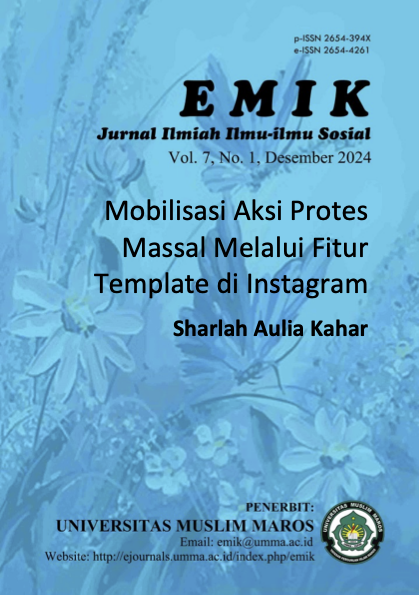Mobilisasi Aksi Protes Massal Melalui Fitur Template di Instagram
DOI:
https://doi.org/10.46918/emik.v8i1.2631Keywords:
template feature, mass protests, mobilizing, cyber community, trends, short narrativeAbstract
Social media as a sophisticated technology presented by humans has become a medium for mobilizing mass protests, especially Instagram in this modern era. One of the features on Instagram, namely the template feature, has become a new medium for carrying out mass protests. In this article, we will discuss how the template feature becomes a medium for mobilizing spontaneous mass protests on Instagram which becomes a space for public participation in determining the direction of policy which in this case is interpreted as cyberdemocracy.
This qualitative research was conducted using a netnographic approach. Netnographic research is used to explore culture in digital space, especially how people utilize digital space in activism movements through the template feature on Instagram. This study involved twelve informants aged (between 21 and 32 years) and acted as template makers and template distributors. Data collection in this study used observation and in-depth interview methods that lasted for six months.
Mass protests through the template feature on Instagram discussed various issues ranging from problems related to sexual violence, government policies, human rights violations, and various other issues that are currently occurring in society. This action occurred due to the limitations of real space in voicing public aspirations and driven by the tendency to follow trends (virality). This template feature is used as a mobilization medium because the use of features that are more practical and easy to disseminate. In addition, the public can more easily accept the information conveyed through this template feature because of the presentation of the protest narrative which is made concisely. By utilizing this feature as a medium for mass protest actions on Instagram, it becomes a space for conveying public opinion in an effort to intervene in public policy.
References
Akbar, R. S., Aulya, A., Psari, A. A., & Sofia, L. (2019). Ketakutan akan kehilangan momen (FoMO) pada remaja kota Samarinda. Psikostudia J. Psikol, 7(2):38-47, https://e-journals.unmul.ac.id/index.php/PSIKO/article/view/2404, diakses tanggal 20 April 2025.
Anderson, P. & Lee, K. (2019). The Boundless Space of Social Media: Understanding Digital Interaction. Journal of Digital Communication, 34(2):95-110, https://www.academia.edu/30511847/Understanding_Digital_Marketing_DAMIA, diakses tanggal 15 Desember 2024.
Angesti, R., & Oriza, I. I. D. (2019). Peran Fear of Missing Out (FoMO) sebagai mediator antara kepribadian dan penggunaan internet bermasalah. Jurnal Muara Ilmu Sosial, Humaniora, dan Seni, 2(2):790-800, https://journal.untar.ac.id/index.php/jmishumsen/article/view/2317/2841, diakses tanggal 20 April 2025.
Anshoril, I., Alinta, F. A. (2023). Peran Ruang Digital Sebagai Transformasi Gerakan Aksi Sosial Mahasiswa Melalui Platform Sosial Media. Jurnal Analisa Sosiologi, 12(2): 343-362, https://jurnal.uns.ac.id/jas/article/view/68981/40473, diakses tanggal 9 September 2024.
Apriyani, T. (2021). Peran Sosial Media pada Gerakan Protes Massa Aksi dan Demokrasi Baru di Era Digital. Kalijaga Journal of Communication, 3(1): 17-30, https://ejournal.uin-suka.ac.id/dakwah/kjc/article/view/31-02/1461, diakses tanggal 9 September 2024.
Castells, M. (2012). Networks of Outrage and Hope: Social Movements in the Internet Age. Cambridge: Polity Press.
Ema, E., & Nayiroh, L. (2024). Komunikasi Media Sosial Sebagai Alat Mobilisasi Gerakan Sosial Di Indonesia. Jurnal Ilmu Komunikasi UHO: Jurnal Penelitian Kajian Ilmu Komunikasi dan Informasi, 9(1): 221-238, https://jurnalilmukomunikasi.uho.ac.id/index.php/journal/article/download/159/118/1421, diakses tanggal 9 Desember 2024.
Faisyal (2020). Negara Di Tengah Ancaman Demokrasi Siber. Jurnal Oratio Directa, 2(2): 233-250, https://www.ejurnal.ubk.ac.id/index.php/oratio/article/download/120/80, diakses tanggal 17 Desember 2024.
Gatara, A. A. S. (2016). Demokrasi Nothing: Kritik Terhadap Konsep dan Praktek Cyber Democracy. Jurnal Dialog Kebijakan Publik, (22): 1-11, https://digilib.uinsgd.ac.id/19866/1/Junal%20Dialog%20Kebijakan%20Publik.pdf, diakses tanggal 9 Desember 2024.
Kartika, A. (2021). Gerakan Sosial Digital “Warga Bantu Warga” Sebagai Respons Masyarakat Indonesia dalam Menghadapi Pandemi. Brawijaya Journal of Sosial Science, 1(1): 14-30, https://bjss.ub.ac.id/index.php/bjss/article/view/7, diakses tanggal 5 Desember 2024.
Kozinets, R. V. (2009). Netnography: Doing Ethnographic Research Online. London: Sage.
Putri, I. R. (2022). Aktivisme Digital dan Pemanfaatan Media Baru Sebagai Pendekatan Pemberdayaan Masyarakat Atas Isu Lingkungan. Bricolage: Jurnal Magister Ilmu Komunikasi, 8(2): 231-246, https://journal.ubm.ac.id/index.php/bricolage/article/view/3303/0, diakses tanggal 9 Desember 2024.
Sasnur, N. H. (2023). Studi Netnografi Akun Tiktok Sebagai Media Informasi Kasus “Sambo.” Skripsi, Universitas Islam Negeri Sultan Syarif Kasim Riau, Riau.
Smith, J., & Johnson, P. (2020). The Influence of Social Media on Social Identity and Communication. Journal of Digital Communication Studies, 2(1): 12-18, https://digitalscience.pubmedia.id/index.php/pssh/article/view/241, diakses tanggal 15 Desember 2024.
Sukmana, O. (2016). Konsep dan Teori Gerakan Sosial. Malang: Intrans Publishing
Susanto, R. D., & Irwansyah. (2021). Media Sosial, Demokrasi, dan Penyampaian Pendapat Politik Milenial Di Era Pasca-Reformasi. LONTAR: Jurnal Ilmu Komunikasi, 9(1): 65-77, https://ejurnal.lppmunsera.org/index.php/LONTAR/article/view/3249, diakses tanggal 11 Januari 2025.

Downloads
Published
Issue
Section
License
Copyright (c) 2025 Sharlah Aulia Kahar

This work is licensed under a Creative Commons Attribution-ShareAlike 4.0 International License.









9.png)















